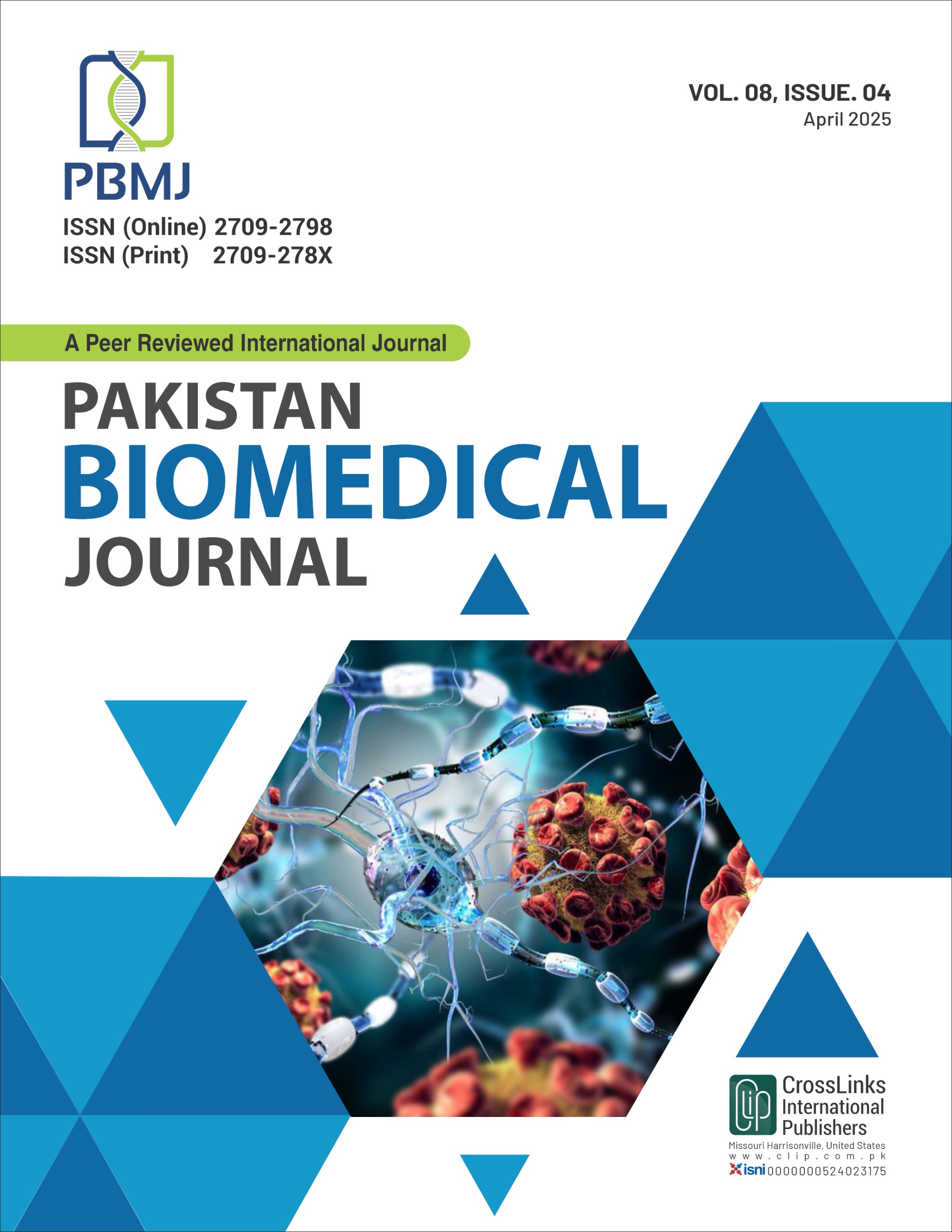Association of Screen Time and Headache and Its Impact on ADLs in Freelancers
Screen Time and Headache and Its Impact on ADLs
DOI:
https://doi.org/10.54393/pbmj.v8i4.1234Keywords:
Cervicogenic Headache, Impairments, Pain Intensity, MigraineAbstract
Freelancers are especially vulnerable to Cervicogenic headaches and migraines as a result of prolonged screen time because of inadequate cervical neck curvature and over-illumination. Persistent migraine and Cervicogenic headaches can have a significant impact on a person’s activities of daily life. Objectives: To evaluate the relationship between screen time and headaches and their effects on activities of daily living. Methods: The data of 200 freelancers were collected within 3 months of age 18-45, and descriptive statistics and correlation analysis were done to explore the associations between screen time, headaches, and activities of daily living. Results: The mean age of participants was 25, with 77% of freelancers having Cervicogenic headaches and 23% Migraine, among which 25.5% had mild pain, 49.5% had moderate pain, and 25% had severe headaches. The HALDI score of 60.77% showed that freelancers had severe impairments in activities of daily living caused by migraine or Cervicogenic headaches. A p-value of 0.00 showed that screen time was significantly associated with headaches, and a p-value of 0.017 revealed a significant impact of headaches on freelancers' activities in daily life. Conclusions: It was concluded that screen time is significantly associated with headaches, and freelancers suffering from migraine or Cervicogenic headaches can have a severe impact on activities in daily life.
References
Blaising A, Kotturi Y, Kulkarni C, Dabbish L. Making it work, or not: A longitudinal study of career trajectories among online freelancers. Proceedings of the ACM on Human-Computer Interaction. 2021 Jan; 4(CSCW3): 1-29. doi: 10.1145/3432925.
Arifianto C, Vallentino M. A Study and Review of Freelancer Value Proposition. Journal of Research in Business, Economics, and Education. 2022 May; 4(1): 50-62.
Abou Hashish EA, Baatiah NY, Bashaweeh AH, Kattan AM. The Online Learning Experience and Reported Headaches Associated with Screen Exposure Time Among Saudi Health Sciences Students During the COVID-19 Pandemic. BioMed Central Medical Education. 2022 Apr; 22(1): 226. doi: 10.1186/s12909-022-03235-8.
Afzal F, Atif MM, Kumar A, Rasul A, Islam A, Nadeem I. Cervicogenic Headache and Neck Pain among Computer Users. Rawal Medical Journal. 2020 Apr; 45(2): 370-2.
Montagni I, Guichard E, Carpenet C, Tzourio C, Kurth T. Screen Time Exposure and Reporting of Headaches in Young Adults: A Cross-Sectional Study. Cephalalgia. 2016 Oct; 36(11): 1020-7. doi: 10.1177/0333102415620286.
Lipton RB, Lee L, Saikali NP, Bell J, Cohen JM. Effect of Headache-Free Days on Disability, Productivity, Quality of Life, and Costs Among Individuals with Migraine. Journal of Managed Care and Specialty Pharmacy. 2020 Oct; 26(10): 1344-52. doi: 10.18553/jmcp.2020.20103.
Lund J, Berring-Uldum A, Colak M, Debes NM. Headache in Children and Adolescents: The Association Between Screen Time and Headache within a Clinical Headache Population. Neuropediatric. 2022 Aug; 53(04): 221-6. doi: 10.1055/s-0041-1740550.
Syahputri VN, Rahma EA, Setiyana R, Diana S, Parlindungan F. Online Learning Drawbacks During the Covid-19 Pandemic: A Psychological Perspective. English Journal of Merdeka: Culture, Language, and Teaching of English. 2020 Dec; 5(2): 108-16. doi: 10.26905/enjourme.v5i2.5005.
Choudhary MB, Choudary AB, Jamal S, Kumar R, Jamal S. The Impact of Ergonomics on Children Studying Online During COVID-19 Lockdown. Journal of Advances in Sports and Physical Education. 2020; 3(8): 117-20. doi: 10.36348/jaspe.2020.v03i08.001.
Sakai F, Hirata K, Igarashi H, Takeshima T, Nakayama T, Sano H et al. A Study to Investigate the Prevalence of Headache Disorders and Migraine among People Registered in a Health Insurance Association in Japan. The Journal of Headache and Pain. 2022 Dec; 23(1): 70. doi: 10.1186/s10194-022-01439-3.
Im HJ, Hong YH, Cho SJ. Neck Pain Disability on Headache Impact and the Association Between Sleep Disturbance and Neck Pain in Migraine. Journal of Clinical Medicine. 2023 Jun; 12(12): 3989. doi: 10.3390/jcm12123989.
Xu Y, Gao Y, Jiang L, Wu L, Yin J, Yang Z et al. Global Trends In Research on Cervicogenic Headache: A Bibliometric Analysis. Frontiers in Neurology. 2023 Apr 20; 14: 1169477. doi: 10.3389/fneur.2023.1169477.
Rosignoli C, Ornello R, Onofri A, Caponnetto V, Grazzi L, Raggi A et al. Applying a Biopsychosocial Model to Migraine: Rationale and Clinical Implications. The Journal of Headache and Pain. 2022 Dec; 23(1): 100. doi: 10.1186/s10194-022-01471-3.
Cokyaman T and Ozcan Erdem U. Use of ICHD-3rd Diagnostic Criteria in Determining the Prevalence of Migraine in Childhood; School-Based Cross-Sectional Questionnaire Study. Neurological Research. 2024 Dec; 46(12): 1130-6. doi: 10.1080/01616412.2024.2403860.
Antonaci F, Ghirmai S, Bono G, Sandrini G, Nappi G. Cervicogenic Headache: Evaluation of the Original Diagnostic Criteria. Cephalalgia. 2001 Jun; 21(5): 573-83. doi: 10.1046/j.0333-1024.2001.00207.x.
Anarte-Lazo E, Carvalho GF, Schwarz A, Luedtke K, Falla D. Differentiating Migraine, Cervicogenic Headache and Asymptomatic Individuals Based on Physical Examination Findings: A Systematic Review and Meta-Analysis. BioMed Central Musculoskeletal Disorders. 2021 Dec; 22: 1-8. doi: 10.1186/s12891-021-04595-w.
Vernon H and Lawson G. Development of the Headache Activities of Daily Living Index: Initial Validity Study. Journal of Manipulative and Physiological Therapeutics. 2015 Feb; 38(2): 102-11. doi: 10.1016/j.jmpt.2014.12.002.
Roy S, Iktidar MA, Chowdhury S, Pulock OS, Pinky SD, Sharif AB. Increased Screen Time and Its Association to Migraine and Tension-Type Headache: A Cross-Sectional Investigation among Bangladeshi Students. British Medical Journal Neurology Open. 2024 May; 6(1): e000656. doi: 10.1136/bmjno-2024-000656.
Ambah T, Abidoye FE, McCalla CA, Kalejaiye M, Ihunda IC, Onwua-maegbu et al. Digital Age Headaches: Exploring the Neurological Impact of Screen Time and Blue Light. International Journal of Clinical and Medical Case Reports. 2025; 49 (3). doi: 10.46998/IJCMCR.2025.49.001212.
Ligthart L, Gerrits MM, Boomsma DI, Penninx BW. Anxiety and Depression Are Associated with Migraine and Pain in General: An Investigation of the Interrelationships. The Journal of Pain. 2013 Apr; 14(4): 363-70. doi: 10.1016/j.jpain.2012.12.006.
Awaki E, Takeshima T, Matsumori Y, Hirata K, Miyazaki N, Takemura R et al. Impact of Migraine on Daily Life: Results of the Observational Survey of the Epidemiology, Treatment, and Care of Migraine (OVERCOME [Japan]) study. Neurology and Therapy. 2024 Feb; 13(1): 165-82. doi: 10.1007/s40120-023-00569-3.
Downloads
Published
How to Cite
Issue
Section
License
Copyright (c) 2025 Pakistan BioMedical Journal

This work is licensed under a Creative Commons Attribution 4.0 International License.
This is an open-access journal and all the published articles / items are distributed under the terms of the Creative Commons Attribution License, which permits unrestricted use, distribution, and reproduction in any medium, provided the original author and source are credited. For comments editor@pakistanbmj.com











